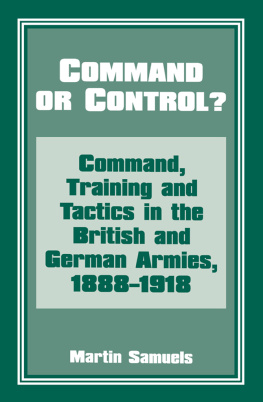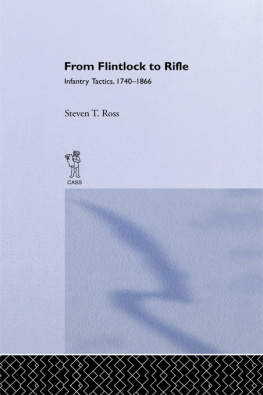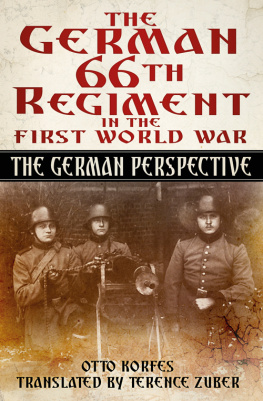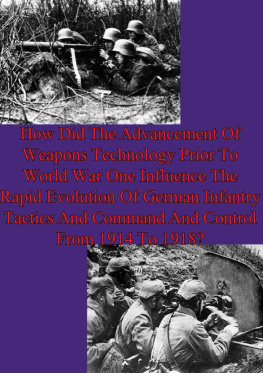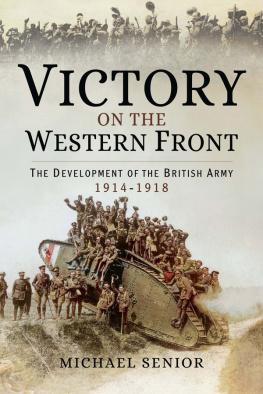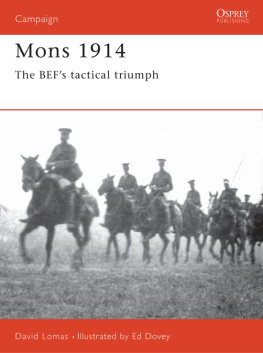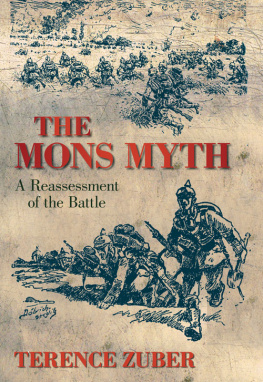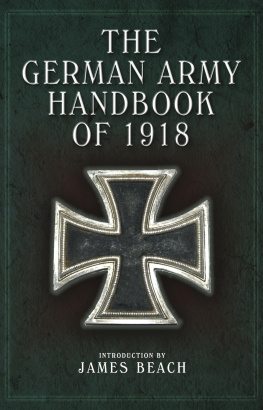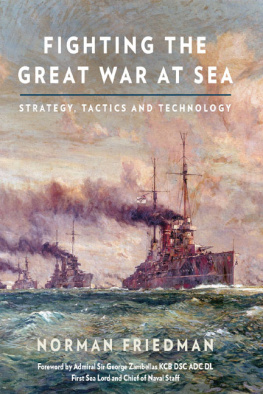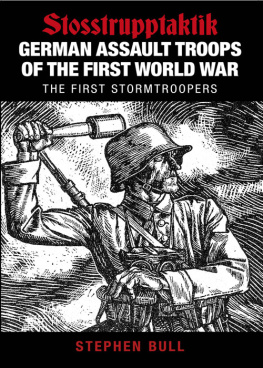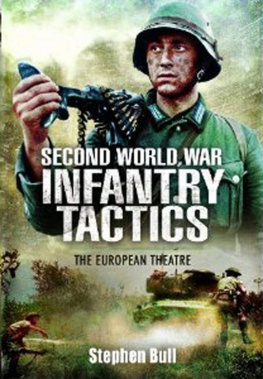COMMAND
OR CONTROL?
COMMAND
OR CONTROL?
Command, Training and Tactics
in the
British and German Armies,
18881918
MARTIN SAMUELS
First published in 1995 in Great Britain by
FRANK CASS PUBLISHERS
Crown House, 47 Chase Side
Southgate, London N14 5BP
and in the United States of America by
FRANK CASS PUBLISHERS
ISBS, 5824 N.E. Hassalo Street
Portland, Oregon 972133644
Website: www.frankcass.com
Copyright 1995 Martin Samuels
Reprinted 2003
British Library of Cataloguing in Publication Data
Samuels, Martin
Command or Control?: Command, Training
and Tactics in the British and German
Armies, 18881918
I. Title
355.5
ISBN 0-7146-4570-2 (cloth)
ISBN 0-7146-4214-2 (paper)
ISBN 978-1-1352-3849-0 (ePub)
Library of Congress Cataloging-in-Publication Data
Samuels, Martin.
Command or control?: command, training, and tactics in the British and German armies, 18881918 / Martin Samuels.
p. cm.
Includes bibliographical references and index.
ISBN 0-7146-4570-2 (cloth); 0-7146-4214-2 (paper)
1. Military doctrine-Great Britain-History-19th century. 2. Military doctrine-Great Britain-History-20th century. 3. Military doctrine-Germany-History-19th century. 4. Military doctrine-Germany-History-20th century. 5. Great Britain. Army-Organization. 6. Germany. Heer-Organization. 7. Great Britain. Army-Drill and tactics. 8. Germany. Heer-Drill and tactics.
I. Title.
UA647.S182 1995
355.033541-dc20
95-7053
CIP
All rights reserved. No part of this publication may be produced in any form or by any means, electronic, mechanical, photocopying, recording or otherwise, without the prior permission of Frank Cass Publishers.
Typset in 10pt/12pt Ehrhardt
by Vitaset, Paddock Wood, Kent
Reprinted in Great Britain
Anthony Rowe, Eastbourne, Sussex
Contents
For three-quarters of a century, from its victory in the Franco-Prussian war of 187071 until its defeat in the Gtterdmmerung of 1945, the German army stood out from all its rivals by virtue of the sheer excellence of its fighting power. Other armies incorporated within their ranks specialised units which could demonstrate high levels of tactical virtuosity, and larger formations could and did perform outstandingly on individual battlefields. But for consistent excellence in combat performance the German army set a standard which none of its rivals could match. Indeed, Germanys defeats in the two world wars are now often ascribed to a degree of strategic ineptness, and a proclivity to make the same major mistakes twice, which seem in retrospect quite astonishing but which leave the German soldier still the undisputed master of his craft although in neither war was he ultimately master of the field.
The First World War tested the German army as much as it tested all other combatants. Machine guns, barbed-wire, concrete bunkers, gas and high explosive shell combined to create an entirely new kind of battlefield. To survive and to succeed required that the pre-war rules of attack and defence be fundamentally rethought and reformulated, and that the new doctrines which resulted from this process then be effectively put into action.
In the pages that follow, Martin Samuels shows both why and how the German and British armies adopted quite different postures in the face of the new twentieth-century battlefield. The extent to which the German army succeeded in its task is evident in the contrast between the operational rigidity of the Schlieffen plan as executed by the German field army in August and September 1914, and the flexibility and fluidity which characterised the Michael offensive which Ludendorff unleashed on 21 March 1918.
In adjusting to the new operational landscape, the German army had one important advantage over its British rival. Ever since 1806, German practice had incorporated a system of directive military command which devolved the control of battle to subordinate commanders. When, at quite an early stage in the war, senior German soldiers recognised that traditional pre-war infantry doctrines, which rested upon linear formations of infantry attacking with fixed bayonets, were quite unsuited to trench warfare, it was therefore possible to accommodate new methods of attack which empowered lower-level commanders to achieve their objectives through the use of dispersed formations and new combat techniques. In terms of both attack and defence and in contradiction to a popular stereotype which still portrays the Great War as a continuous and unvariegated blood-letting the speed with which the German army identified and analysed the new problems of attack and defence and evolved effective answers to them is quite remarkable. However, a command structure characterised by flexibility and a readiness to listen to creative criticism from relatively junior officers could show occasional signs of bureaucratic rigidity: despite its efforts, the German General Staff could not get the artillery expert Colonel Bruchmller promoted to the rank of permanent colonel.
In contrast to Germany, Great Britain lacked both an established General Staff and an intellectual tradition to accompany it. A very different pattern of British generalship had developed by 1914 and persisted during the war one which combined rigidity and inflexibility in planning with a marked reluctance on the part of senior commanders to interfere with any aspect of their subordinates handling of divisions or corps. In the British army, disdain for or incomprehension of the kind of staff work which was characteristic of the German command system was both deep-rooted and long-lived: as late as 1941, discarding strategic and operational skills, Field Marshal Lord Wavell opined that administration was the real crux of generalship.
It is perhaps scarcely surprising, then, to learn that the British GHQ possessed no equivalent to the German sections which developed and tested new tactical doctrines. Even the best Corps instructional schools such as Maxses XVIII Corps School, set up in 1917, had no authority to enforce their methods on lower commanders. An even more telling observation which Martin Samuels draws from his analysis is that the British Army would probably have been unable to implement German doctrines even if they had properly understood them, as they required skills and practices which were beyond the capabilities of most British officers and men.
By juxtaposing the German and British armies as models for historical analysis, and by contrasting structural and functional differences between them as they went about their business of fighting one another between 1914 and 1918, Martin Samuels makes an important contribution to the literature of military effectiveness. The result is a genuinely comparative military history which, by contrasting two very different military institutions, matched against one another for four bloody years of continuous campaign, highlights the vital ingredients of German combat excellence. After critically re-examining them during the inter-war years, the Reichswehr would apply the doctrines devised by its predecessor to the campaigns of 193941. Thus, the Imperial German Army can fairly claim to have invented modern warfare during the Great War.
JOHN GOOCH
The writing of this book was aided by the support of a number of people. The British Academy awarded me the financial assistance necessary for the research to be undertaken. The staff of the following establishments gave me invaluable help in gathering material: the departments of Printed Books and Documents at the Imperial War Museum; the Tactical Doctrine Retrieval Cell and the library of the Staff College, Camberley; the Liddell Hart Centre for Military Archives at Kings College, London; the British Library; and the Public Record Office, Kew. Particular thanks are owed to the Trustees of the Liddell Hart Centre for Military Archives for permission to use and to quote from archives in their care. My thesis supervisor, Michael Elliott-Bateman, of the Department of Military Studies, University of Manchester, spent many hours discussing my ideas and provided constructive criticism of the manuscript. My wife, Helen, drew the maps and gave me support throughout. All translations from sources given in German in the bibliography are mine. Any errors or omissions are my own.

